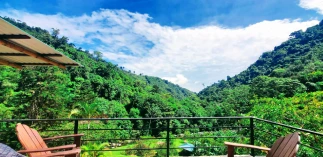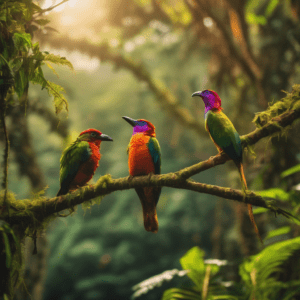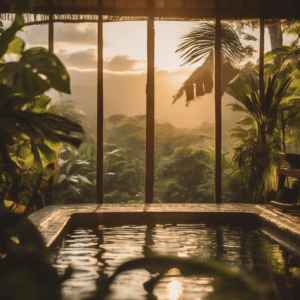Costa Rica stands as a sanctuary where nature and mindfulness coexist. With its rich biodiversity and carefully protected ecosystems, the country offers a rare chance to experience wildlife responsibly. Birdwatching here is more than a visual pleasure—it’s a practice deeply tied to conservation ethics and eco-awareness. The commitment to Sustainable tourism Costa Rica ensures that each binocular lift contributes not only to admiration but to protection, education, and the well-being of both local communities and avian species.
The Soul of Costa Rican Birdlife
Across its tropical rainforests, highland cloud canopies, and coastal mangroves, Costa Rica shelters over 900 bird species. The country’s position as a biological corridor between North and South America makes it a vital resting point for migratory birds and a permanent home for numerous endemic species.
From the glistening Resplendent Quetzal in the misty highlands to the scarlet macaws adorning Pacific skies, birdwatching here feels like witnessing a living masterpiece. The key lies not just in seeing them, but in how one observes—mindfully, quietly, and without disrupting their rhythm.
The Roots of Sustainable Birdwatching
Sustainability is not an accessory to birdwatching in Costa Rica; it is the very foundation. The country’s protected areas, eco-lodges, and conservation programs ensure that observation never becomes intrusion. Sustainable birdwatching involves practices such as:
- Using eco-certified lodgings near reserves to reduce travel emissions.
- Joining small-group guided walks to minimize environmental disturbance.
- Respecting nesting zones and keeping an ethical distance from wildlife.
- Supporting local guides trained in ornithology and habitat preservation.
- Participating in citizen-science programs that record sightings to aid research.
Every observer becomes part of a shared ecological effort, where tourism transforms into a tool for preservation rather than exploitation.
The Importance of Habitat Diversity
Costa Rica’s landscape is a mosaic of microclimates, each offering a distinct birding experience. The highland forests nurture resplendent species like the Quetzal and Black Guan. The Pacific mangroves host herons, spoonbills, and kingfishers, while the Caribbean lowlands vibrate with the calls of toucans and tanagers.
This natural variety requires equally diverse conservation strategies. Maintaining wetland integrity, reforesting high-altitude corridors, and regulating visitor access in sensitive areas are all vital. Responsible tourism revenue often funds these initiatives, ensuring that each visitor indirectly supports habitat protection.
The Connection Between Birdwatching and Conservation
Birdwatching’s beauty in Costa Rica goes beyond recreation—it functions as a living conservation mechanism. Ecotourism generates funds that flow directly into local communities and protected area maintenance. When visitors arrive for birding experiences, they invest in the ecosystem’s longevity.
Revenue from eco-lodges, entrance fees, and birding tours often funds ranger salaries, reforestation projects, and habitat restoration programs. Moreover, community-based tourism empowers rural populations, encouraging them to value living ecosystems over short-term land-use changes.
In this cycle, birds are not only ambassadors of nature but economic allies that keep forests standing.
The Quiet Art of Observation
Sustainable birdwatching emphasizes patience over pursuit. It invites silence, respect, and immersion. The stillness of dawn walks, the distant whistle of a motmot, and the rustle of wings in the canopy create a meditative connection between human and habitat.
Observers are encouraged to leave no trace—no litter, no noise, and no interference. By adopting ethical codes of conduct, birdwatchers maintain the integrity of the environment they cherish. Over time, this quiet form of engagement cultivates deeper environmental awareness among travelers.
Endemic Birds and the Need for Protection
Costa Rica’s small size belies its ecological importance. Certain species—such as the Coppery-headed Emerald, Cabanis’s Ground-Sparrow, and the Mangrove Hummingbird—exist nowhere else. Their limited range makes them vulnerable to deforestation, agricultural expansion, and climate shifts.
Conservation organizations and eco-tourism cooperatives dedicate resources to protecting these fragile species through:
- Native tree replanting in fragmented habitats.
- Creating ecological corridors that link isolated reserves.
- Conducting breeding and monitoring programs.
- Educating visitors about the role of native plants in bird survival.
By integrating these initiatives with tourism, visitors directly support the endurance of Costa Rica’s rarest birds.
The Ethical Role of Eco-Lodges
Many birdwatchers choose accommodations designed to harmonize with nature. These eco-lodges often sit near forest edges or biological corridors, offering easy access to early-morning birding walks while minimizing land impact. Their structures are typically built with sustainable materials, solar energy systems, and water-recycling setups.
Guests contribute by following eco-guidelines—reducing plastic use, staying on designated paths, and respecting quiet hours. The lodging experience becomes part of the larger conservation network, turning temporary stays into lasting contributions.
Seasons of Birdwatching
Costa Rica’s tropical location provides opportunities for birdwatching throughout the year. However, certain months bring heightened activity:
- December to April: Clear skies and abundant fruiting trees attract migratory species.
- May to August: The breeding season in many regions fills forests with mating calls and vibrant plumage.
- September to November: The Caribbean coast welcomes migratory raptors from North America.
Understanding these seasonal rhythms helps birdwatchers plan responsibly and avoid overcrowding fragile ecosystems during peak times.
The Role of Community in Sustainable Birdwatching
Rural and Indigenous communities often stand as the first guardians of Costa Rica’s avian diversity. Their involvement in birdwatching tourism ensures that benefits circulate locally rather than being centralized.
Many residents train as guides, habitat monitors, and eco-lodge hosts. This inclusion creates financial incentives to preserve forests instead of converting them into agricultural land. When tourism honors traditional knowledge and local stewardship, sustainability becomes cultural as well as ecological.
Challenges in Balancing Tourism and Conservation
Despite Costa Rica’s success in conservation-oriented tourism, challenges persist. Habitat loss, climate change, and unregulated visitor numbers in certain regions threaten ecological balance. The key lies in maintaining visitor awareness and responsible tourism management.
Some of the most pressing challenges include:
- Overcrowding in popular reserves is disrupting nesting behavior.
- Litter and noise pollution are affecting bird habitats.
- Insufficient monitoring in remote regions.
- The pressure of new infrastructure on migration corridors.
Addressing these issues requires consistent collaboration between government bodies, local organizations, and travelers who choose mindful practices.
The Power of Citizen Science
Citizen involvement has become a driving force in Costa Rican bird conservation. Visitors participate in biodiversity surveys and bird counts, adding valuable data for researchers. These efforts map migration patterns, monitor population changes, and detect emerging threats early.
Birdwatching apps and community science projects connect amateurs and experts in a shared mission: to observe, record, and protect. Through simple acts—logging a sighting or reporting unusual species—ordinary people contribute to extraordinary conservation outcomes.
Education Through Experience
Every birdwatching journey becomes an open-air classroom. Observers gain a deeper sense of how interconnected species, climate, and human activity truly are. Schools and local initiatives often integrate birdwatching into environmental education programs, instilling respect for wildlife in younger generations.
These experiences nurture a lifelong commitment to protecting nature. When children grow up witnessing the beauty of a toucan’s flight or the patience of a heron at dawn, conservation transforms from an abstract concept into a living value.
The Role of Protected Areas
Costa Rica’s system of national parks and wildlife refuges covers over a quarter of its land. These sanctuaries form the backbone of the nation’s birdwatching culture. Each reserve safeguards a unique ecosystem, from the cloud-drenched Monteverde forests to the lowland rainforests of Osa Peninsula.
Entrance fees fund management programs, while visitor limits maintain ecological equilibrium. Sustainable tourism policies ensure that every visitor leaves a positive imprint—financially and environmentally.
Responsible Equipment Use
Ethical birdwatching extends even to the equipment one carries. Lightweight binoculars, eco-friendly field guides, and reusable water bottles make a difference. Flash photography and sound playback devices should be used sparingly, as they can startle birds and interrupt natural behaviors.
By prioritizing minimalism and respect, birdwatchers transform technology into a tool for observation rather than interference.
Birdwatching Hotspots for Sustainable Travelers
Costa Rica offers an abundance of destinations suited for eco-conscious birdwatchers. Each region reflects a different tone of its avian symphony:
- Monteverde Cloud Forest: Misty canopies shelter resplendent quetzals and hummingbirds.
- Osa Peninsula: Rich rainforests host scarlet macaws, toucans, and countless migratory species.
- Tortuguero National Park: Wetland corridors filled with herons and kingfishers.
- Sarapiquí Region: A biodiverse haven for tanagers, manakins, and honeycreepers.
- Central Highlands: Cool climates support high-altitude species found nowhere else.
These locations embrace responsible tourism models, limiting human impact while enhancing ecological awareness.
Birdwatching as a Cultural Experience
In Costa Rica, birdwatching isn’t only scientific—it’s cultural. Folk traditions, Indigenous stories, and local art often celebrate bird symbolism. The quetzal, for example, represents freedom and spiritual connection across Central America.
Integrating these cultural narratives into eco-tourism deepens appreciation for both wildlife and human heritage. It encourages visitors to see conservation as a form of cultural preservation.
Climate and the Future of Birdwatching
As climate patterns shift, so do migration routes and nesting habits. Costa Rica’s ongoing research and reforestation efforts aim to safeguard climate-resilient habitats. The participation of travelers, conservationists, and policymakers alike ensures that future generations can still witness the brilliance of its avifauna.
Sustainable tourism policies, reforestation programs, and renewable energy initiatives continue to set global standards for eco-tourism and biodiversity protection.
A Sustainable Vision for the Skies Ahead
Birdwatching in Costa Rica is a quiet celebration of life. Each feathered silhouette carries a message of balance between admiration and responsibility. The country has shown that eco-tourism, when guided by care and consciousness, can heal habitats and nurture communities.
The song of sustainability resounds through its forests and coasts—a call not only to witness but to participate. Every mindful glance toward a branch or flight path becomes a gesture of conservation, echoing through the canopy and into the future.







